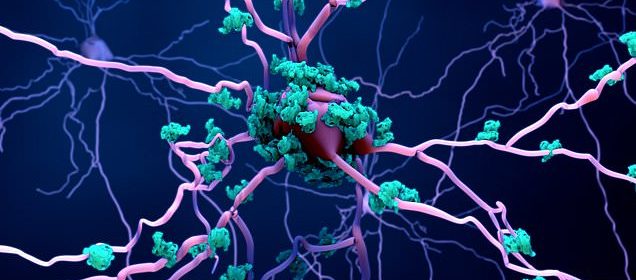Scientists reverse symptoms of Alzheimer's by disrupting toxic protein

Alzheimer’s hope as scientists find a way to reverse symptoms by disrupting two toxic proteins that team up together to damage memory
- Amyloid beta and tau are understood to play a role in dementia
- Until now, it wasn’t clear how they may interact together, scientists said
- Studies found the proteins hamper brain messaging in synapses
- The changes were reversed when genetic tools reduced tau levels
Disrupting two toxic proteins that damage memory may reverse the symptoms of Alzheimer’s, researchers claim.
Evidence is mounting that amyloid beta and tau play a role in the memory-robbing disorder – but how they interact has always been a mystery.
Studies on mice and human brain tissue have now found the proteins work together to suppress key genes in the brain.
Academics said this disrupts messages being sent between brain cells, potentially explaining the difficulties Alzheimer’s patients face.
The research also found they could reduce some of the symptoms of Alzheimer’s in mice by genetically reducing levels of tau.
Disrupting two toxic proteins that damage memory can reverse the symptoms of Alzheimer’s, scientists have found in mice studies. Pictured, illustration of brain cells being killed
University of Edinburgh scientists hope the findings may lead to a treatment for the disease, which strikes millions across the globe.
It is thought the proteins impair brain communication by building up in connection points between cells known as synapses.
Synapses allow chemical and electrical messages to flow and are vital to healthy brain function.
Lead researcher Professor Tara-Spires Jones said: ‘In both the mouse model and in brain tissue from people with Alzheimer’s disease, we found clumps of amyloid beta and tau proteins in synapses.
‘When both amyloid beta and tau were present in the brain, genes that control the function of synapses were less active.’
The proteins also caused some genes to become excessively active, such as those that produce immune cells called microglia.
Microglia have been found in recent studies to kill vital neurons and block synapses in patients with Alzheimer’s.
Stopping the damage that the two proteins cause to synapses could help scientists prevent or reverse dementia symptoms, the researchers say.
Mice showed reduced symptoms of Alzheimer’s after the build-up of tau in their synapses was genetically lowered.
This was measured by their hyperactive behaviour – a reliable indication of Alzheimer’s in mice.
Alzheimer’s disease is the most common form of dementia, affecting some 850,000 people in the UK.
This figure is predicted to rise to more than one million by 2025. There is currently no cure.
Professor Jones said: ‘More work is needed to take what we’ve learned in this study and find therapeutics – but this is a step in the right direction, giving us new targets to work towards.
‘Current treatments are only minimally effective and do not prevent brain degeneration or cognitive decline.
‘Stopping the damage that the two proteins cause to synapses could help scientists prevent or reverse dementia symptoms.’
Dr James Pickett, head of research at Alzheimer’s Society, said: ‘Amyloid and tau have long been considered the key players in Alzheimer’s disease.
‘By focusing on the connections between cells in the brain, these researchers have highlighted the importance of understanding how – independently and together – these proteins damage nerve cells.
‘Other research has shown that treating cognitive decline by targeting amyloid is very difficult, but this research emphasises that novel drugs that target tau could hold the key to reducing damage to the connections between cells.
‘In the grand scheme of things, we know so little about the brain and how it changes in disease. This is why Alzheimer’s Society helped co-found the UK Dementia Research Institute.’
The study is published in the journal Cell Reports.
WHAT IS DEMENTIA? THE KILLER DISEASE THAT ROBS SUFFERERS OF THEIR MEMORIES
Dementia is an umbrella term used to describe a range of neurological disorders
A GLOBAL CONCERN
Dementia is an umbrella term used to describe a range of progressive neurological disorders, that is, conditions affecting the brain.
There are many different types of dementia, of which Alzheimer’s disease is the most common.
Some people may have a combination of types of dementia.
Regardless of which type is diagnosed, each person will experience their dementia in their own unique way.
Dementia is a global concern but it is most often seen in wealthier countries, where people are likely to live into very old age.
HOW MANY PEOPLE ARE AFFECTED?
The Alzheimer’s Society reports there are more than 850,000 people living with dementia in the UK today, of which more than 500,000 have Alzheimer’s.
It is estimated that the number of people living with dementia in the UK by 2025 will rise to over 1 million.
In the US, it’s estimated there are 5.5 million Alzheimer’s sufferers. A similar percentage rise is expected in the coming years.
As a person’s age increases, so does the risk of them developing dementia.
Rates of diagnosis are improving but many people with dementia are thought to still be undiagnosed.
IS THERE A CURE?
Currently there is no cure for dementia.
But new drugs can slow down its progression and the earlier it is spotted the more effective treatments are.
Source: Alzheimer’s Society
Source: Read Full Article

